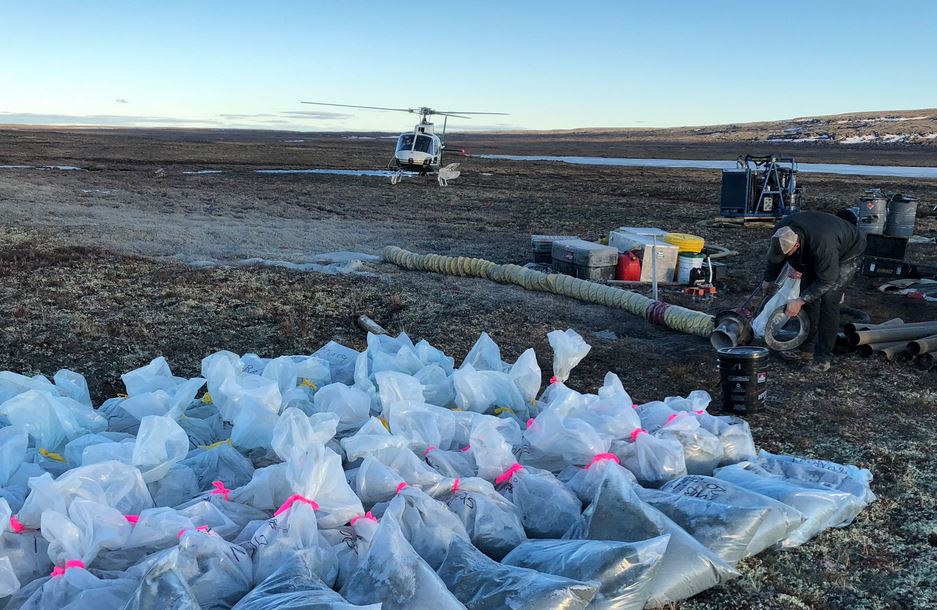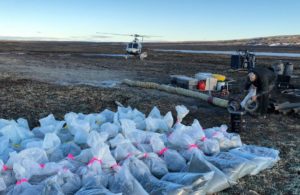Dunnedin down 28% on Nunavut diamond results

Bagged samples from the Kahuna Project awaiting shipment to the lab. Source: Dunnedin Ventures Inc.

Dunnedin Ventures Inc. [DVI-TSXV] was an active trader Thursday October 4 after the company released new diamond results and the completion of summer/fall field work at its 100%-owned Kahuna Diamond Project in Nunavut.
Dunnedin eased 28% or $0.045 to 11.5 cents on volume of over 1.2 million.
The Kahuna Project covers 1,664 km2 and is located 26 km northeast of Rankin Inlet, adjacent to year-round infrastructure at Agnico-Eagle Mines Ltd.‘s [AEM-TSX, NYSE] Meliadine gold mine. Kahuna hosts a high-grade, near surface inferred diamond resource of 4 million carats in two kimberlite dikes (Kahuna and Notch) at an average grade of 1 carat per tonne.
In 2017, the gold rights on the Kahuna property were spun out into a separate company, Solstice Gold Corp. [SGC-TSXV].
Aside from the inferred resource, the Kahuna property is known to contain numerous kimberlite pipe targets, defined in collaboration with Dunnedin’s adviser and largest shareholder (12%) Chuck Fipke. It was Fipke who discovered Canada’s first diamond mine at Ekati, Northwest Territories, where more than 65 million carats have been produced to date.
Having acquired the property in 2014, Dunnedin says it has benefitted from $30 million spent on exploration by previous owners.
When Dunnedin released the maiden inferred resource estimate in January 2015, it said only two of eight confirmed significantly diamondiferous kimberlites (Kahuna and Notch) had sufficient drilling, bulk sampling and density definition work to be included in the resource estimate.
At the time, it said other drilled, mapped and sampled diamondiferous kimberlites had also been identified. They include PST, Killiq, and four additional kimberlite dikes located between the Notch and PST kimberlites (KD-13, 14, 16 and 18).
In a July 19, 2018, news release, the company said it has drill-tested two historic kimberlite pipes (KD900 and KD230) and discovered a new pipe known as KH10-11. The company said all three kimberlites were tested using rotary air-blast drilling during the summer. Approximately one tonne of representative material was sent to CF Mineral Research Ltd. in Kelowna, B.C., for analysis.
On Thursday, the company said 18 diamonds larger than 0.106 millimetres sieve size were recovered from a 133.32-kilogram sample extracted from the KD900 kimberlite.
Indicator minerals from KD900 confirm that while this pipe is diamondiferous, it is not the sole source of high-quality diamond indicator material chemistry present in a 45-square kilometre patch of ground known as the Josephine Target Area (JTA).
Diamond indicator mineral chemistry and indicator dispersion in the JTA suggest that undiscovered kimberlites with the potential to host larger diamonds occur near KD900 and up-ice, the company said.
The JTA is a discreet area of high-quality diamond indicator minerals that are interpreted to be sourced from multiple undiscovered kimberlites.
As part of a 2018 diamond exploration program at Kahuna, the company completed a till sampling campaign during the month of September across the JTA. The aim was to prioritize a number of kimberlite pipe targets for follow-up drilling.
Meanwhile, the company said further diamond drill results on KH10-11 and KD230 will be reported as received, with the next tranche of results expected later this fall.
